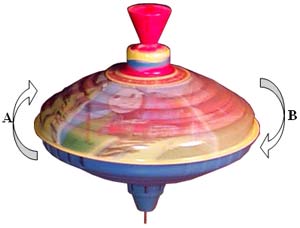Why does the gyro do not fall when spinning?
Of the thousands of people who used to play childhood recalls, few people answered that question. The gyroscope, whether turned upright or tilted, does not fall as expected. Which force keeps it in that unstable state?
Explain the reason that the spin does not fall when spinning
The theory of gyroscopes is quite complicated, and we won't go into that. Here we only talk about the main reason why the spinning spinning machine does not fall.

A drawing of a gyroscope turns in the direction of the arrow. Pay attention to part A of the spin edge, and part B symmetry of A. Part A tends to move away from you, while Part B moves closer. Now follow that when you tilt your axis toward you, how the two parts move.
By such a collision you have forced part A to move upward, and part B goes down. Both parts receive a perpendicular collision to their own motion. But because the gyroscope rotates rapidly, the parts of the disc ring have very high rotational speeds. Therefore, the velocity is insignificant because you transmit it to the very high velocity of a point on the disk ring, forming a very close synthetic speed equal to the speed of rotation. Therefore, the rotation of the rotary is almost unchanged. That's why the gypsum seems to be always against the tendency to make it fall. The heavier the spin and the faster the rotation, the greater the probability of that.
All rotating objects tend to preserve the direction of the axis of rotation . This property is widely used in engineering. Types of gyroscopes (based on the nature of the gyroscope) - the large table, stable machines . installed on aircraft and ships.
- How will the world stop spinning and change the world?
- Dizziness may be due to poisoning or brain tumors
- Ways to prevent colds and flu in the fall
- B-shoe fall prevention shoes
- Anti-fall injury prevention kits
- What kind of catastrophe will people suffer if the Earth stops spinning?
- What happens when the Earth stops spinning?
- Romantic fall America
- What if meteorites fall into the ocean?
- Indian farmers are shocked when meteors fall between rice fields
- Green spider - high-rise buildings escape
- Western Europe: Hot Fall spreads to the East
 'Fine laughs' - Scary and painful torture in ancient times
'Fine laughs' - Scary and painful torture in ancient times The sequence of numbers 142857 of the Egyptian pyramids is known as the strangest number in the world - Why?
The sequence of numbers 142857 of the Egyptian pyramids is known as the strangest number in the world - Why? History of the iron
History of the iron What is alum?
What is alum?